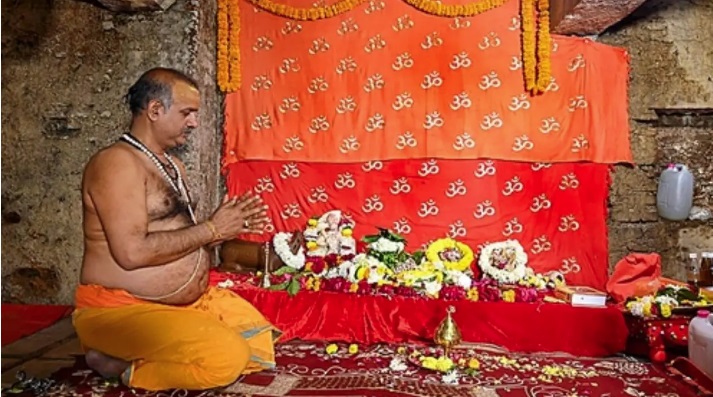Unlocking the Mysteries of Gyanvapi Mosque: A Night of Renewed Prayers-In a significant turn of events, prayers echoed through the cavernous depths of the Gyanvapi mosque after three long decades, following a court order that stirred both curiosity and controversy. The Kashi Vishwanath temple trust president confirmed the resumption of this age-old practice, marking a historic moment in the ongoing legal battle surrounding the mosque adjacent to the revered Kashi Vishwanath temple.
Unlocking the Mysteries of Gyanvapi Mosque: A Night of Renewed Prayers

The Court’s Verdict
The district court’s ruling on Wednesday granted permission for a priest to conduct prayers before the idols in the cellar of the Gyanvapi Masjid. This decision added a new chapter to the legal discourse over this sacred site. This move came after meticulously considering the plea presented by Shailendra Kumar Pathak, asserting the right to worship in the cellar.
A Night of Spiritual Resurgence
The cellar, referred to as “Vyas ji’s cellar,” saw its doors swing open after 31 years, with prayers commencing around 10:30 pm on that memorable Wednesday night. Temple Trust president Nagendra Pandey emphasized the promptness with which the district administration adhered to the court’s orders, orchestrating the resumption of prayers with due diligence.
Court-Mandated Arrangements
The court’s directives included the local administration making arrangements within seven days for prayers in the cellar. This involved setting up “proper arrangements,” including metal barricades at the complex, to facilitate a smooth and organized worship environment. The southern cellar became the focal point for this long-awaited revival.
Controversial Perspectives
As the news broke, some locals claimed that, after a thorough cleaning, an ‘aarti’ of Goddess Lakshmi and Lord Ganesh took place in the cellar. However, the Muslim side contested the petitioner’s version during the court proceedings, stating that no idols existed in the cellar until 1993, challenging the very basis of the claim.
Political Dimensions
The expeditious response of the BJP-led government in complying with the court’s orders didn’t go unnoticed by political rivals. Samajwadi Party President Akhilesh Yadav raised concerns about the haste displayed, suggesting it might be an attempt to circumvent due legal process. The political undertones added a layer of complexity to an already sensitive situation.
Archaeological Revelations
The court’s decision coincided with the release of an Archaeological Survey of India (ASI) report on the mosque complex. This report, ordered by the same court, suggested that the mosque was constructed during Aurangzeb’s rule over the remains of a Hindu temple, injecting historical nuances into an already intricate legal battle.
The Road Ahead
The verdict by Judge A K Vishvesha concluded a series of hearings on the plea filed by Shailendra Kumar Pathak. With the court granting the right to worship to Hindus, Mumtaz Ahmed, representing the Muslim side, expressed disagreement, declaring their intent to challenge the decision in the High Court.
Conclusion
The resumption of prayers in the Gyanvapi mosque’s cellar after a hiatus of three decades marks a pivotal moment in the ongoing legal saga. While it brings a sense of fulfillment to one community, it sparks discontent in another. The intersection of history, faith, and law continues to weave a complex narrative around this sacred site, leaving us to ponder the intricacies of coexistence.
Frequently Asked Questions:
- What led to the discontinuation of prayers in the Gyanvapi mosque’s cellar three decades ago?
- The prayers were halted in 1993 during the tenure of former chief minister Mulayam Singh Yadav after the demolition of the Babri Mosque in Ayodhya in 1992.
- Did the Archaeological Survey of India’s report influence the court’s decision?
- The ASI report, revealing the mosque’s construction over the remains of a Hindu temple, added historical dimensions to the legal proceedings.
- How did the local administration respond to the court’s order to resume prayers?
- The district administration promptly made arrangements, complying with the court’s directives, and ensuring the resumption of prayers within the stipulated timeframe.
- What political implications surround the court’s decision on the Gyanvapi mosque?
- The opposition, particularly Samajwadi Party President Akhilesh Yadav, raised concerns about the expedited compliance, suggesting a potential attempt to bypass due legal process.
- Following the court’s decision, what’s the next step for the Muslim side?
- Mumtaz Ahmed, representing the Muslim side, announced their intention to challenge the decision in the High Court, indicating a continuation of the legal battle.
ALSO READ- The Divine Sovereign- Lord Ram’s Timeless Majesty